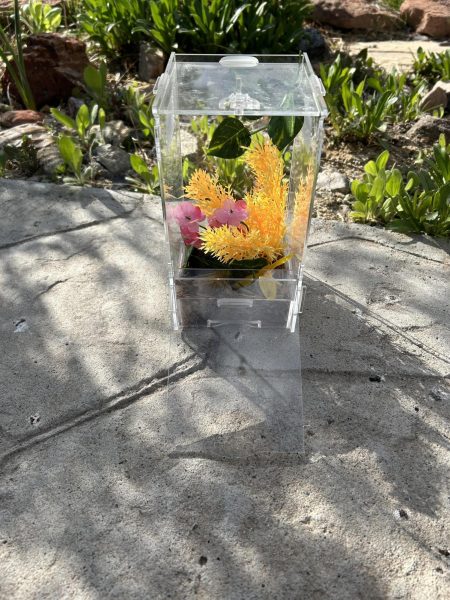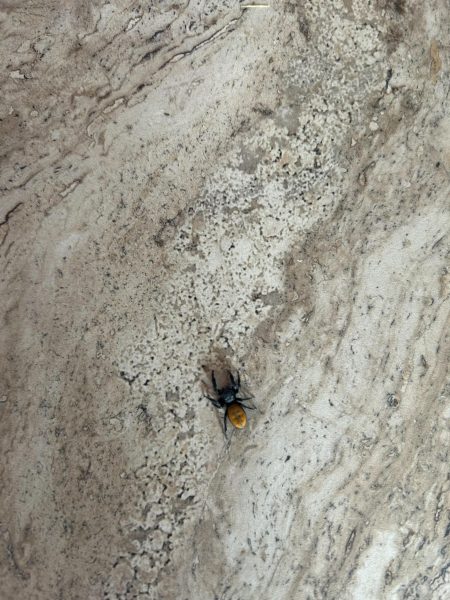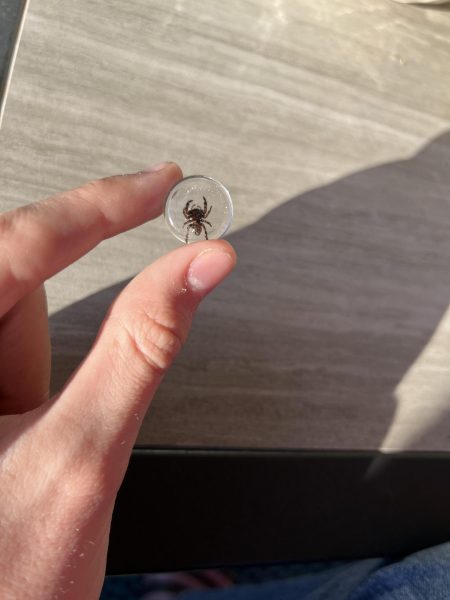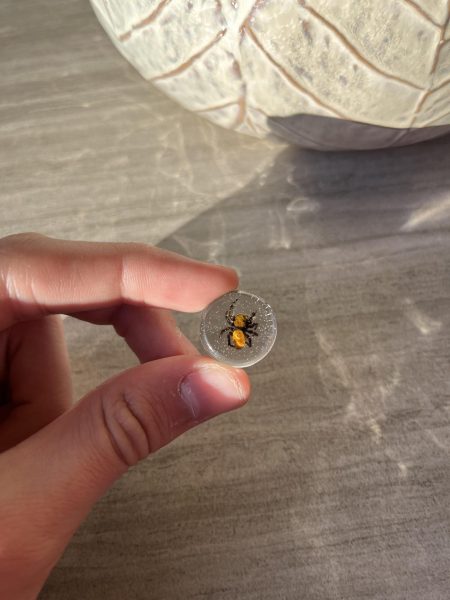Warning! Don’t read on if you have arachnophobia. You might regret it.
Jumping spiders as pets might sound a bit odd. You have probably heard of keeping tarantulas as pets, and you probably knew that one kid in elementary that bragged about having one. But jumping spiders? Although it might sound weird, I believe that these creatures are really the perfect pet.
What is a jumping spider exactly, you ask? Well, they are spiders that jump. Beyond that, they are a type of small spider that lives all over the world. They vary in size from really small, about the size of a sharp pencil point, to nearly an inch. While they can bite, they only do so as a last resort when they feel they are in danger. Being bitten feels like a bee sting, and their venom is also similar to a bee’s, making them really rather harmless. They all have 8 eyes, strong legs, and a knack for jumping. Unlike most spiders, their eyesight is very well developed, meaning that they can see you in detail. The spiders that are the main subject of this article are jumpers of the genus Phidippus (fid-uh-pis). These jumpers are larger, easier to find and identify, and objectively cuter than other types of jumping spiders.
So, how do you keep one of these as pets? I’ll answer that with steps and information from my spider loving friend and mentor in all things arachnid related, Trevor.
Step 1. Make a home. Before you find yourself a spider, you have to find a home to keep it in. Unused tupperware works well, or you can buy a specially made cage for about $25. If you use a tupperware, make sure that it is ventilated by poking small holes in the lid, to keep the spider from dying. They need to breathe too! For decoration, keep it simple. Sand or woodchips work well, while rocks may crush your spider when the cage is moved. Put a few plants, fake or real, into your cage. As Trevor says, “Jumping spiders prefer to inhabit leaves, plants, flowers, and other organic material because it provides a great spot for them to construct a protective web. Due to the many folds and crevices in leaves or flowers, they are able to use much less webbing. The leaves also provide extra concealment and structural support.”

Step 2. Acquire yourself a jumper. This is the tricky part. Buying a spider online is not the greatest idea. The sites are often sketchy and spiders often die in transport. Additionally, their prices are comically high. This leaves you with the second option. Catching your own friend. When this article is re-published, late August, is the start of a window from late July to early October where jumping spiders are fully grown and actively searching for a mate. “This is when the genus Phidippus is active,” says Trevor. “They will begin as spiderlings in early July but quickly mature to a juvenile within a few months, and at this time they are starting to show color and are much larger but are not yet fully matured. Give it another month and they should be fully matured. This phase from September to October is when they are out actively looking for a mate; this is the best time to find them.” During this time, it should be rather easy to find your quarry. Look at the top of a metal fence post, where the upside down U shape meets with the horizontal pole. Two little spaces on either side of the pole are where you will find a jumper. Be careful though, as jumpers are not the only thing to live there. Trevor gives his insight: “I usually use a wooden dowel, preferably about 7 inches long. You need to take extreme caution when doing this, as Jumping spiders are not dangerous to us but Black Widows are. They are also commonly found in these areas, this is why you must always perform a visual check. Make sure the web is small and very thick; this is likely a jumping spider web. If the web is spread out very thin, messy, and there is a large black spider in there, I would recommend keeping your distance.” If, when you put the stick in and coax the spider out, it is a jumper, prepare to catch it. Hold the cage near to the spider and use the lid or the stick to try to force the spider into the cage. “After you have pushed it out of its web it will likely try to flee, but do not panic, as they are harmless and rarely bite. Use your dowel to coax them into the cage. Once they are inside, close the lid and you have just caught a jumping spider. If you don’t have the necessary resources to care for it then release it, but If you do have the resources to give it a better life than it is currently living, feel free to keep it.” This can be difficult, and you might not catch the spider on your first try. Don’t bother that spider for a day or two, because you might stress it out and force it to move.

Step 3. Feed it. So, you have a jumpy friend. To keep that friend around for the months to come, you should probably feed the little guy. “Feeding a jumping spider is very simple,” says Trevor. “All you have to do is go to the pet store and go to the feeder cricket bin, and ask for small crickets or large ones depending on the spider’s size. They can eat things about two times the size of their body. Once you have the crickets, simply grab some tweezers and drop them into the cage, and the spider will eat it in due time.”
Step 4. Keep feeding it. This is rather obvious, isn’t it? To keep your spider alive, it has to eat more than once. These spiders will live a few months to about a year in captivity if you feed them. So, to get the most out of your little friend’s lifespan, feed it regularly. “Feed the spider about 1 to 2 crickets every 2 weeks. Use a water sprayer to mist the spider’s cage every week.” Also, don’t put a water dish in the cage. Spiders get all the water they need from their food and misting, and they don’t drink. They do, however, drown very easily.
That is all there is to it! While they may be small, jumping spiders are really fascinating pets. Your little pet might just surprise you with its intelligence and curiosity.
Below is a gallery of images of various common species of Phidippus, so you can identify your own jumper.




Note – This article was published last year for The Golden Word. It has been revised to reflect the time it was re-published.









